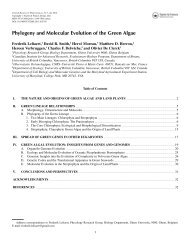Phylogeny and molecular evolution of green algae - Phycology ...
Phylogeny and molecular evolution of green algae - Phycology ...
Phylogeny and molecular evolution of green algae - Phycology ...
You also want an ePaper? Increase the reach of your titles
YUMPU automatically turns print PDFs into web optimized ePapers that Google loves.
28 CHAPTER 2<br />
Progress <strong>and</strong> perspectives<br />
The slow progress in <strong>green</strong> algal phylogenetics can in part be attributed to the limited availability <strong>of</strong><br />
genomic data <strong>and</strong> the difficulties in consistently amplifying single-copy nuclear markers over the<br />
entire spectrum <strong>of</strong> a group <strong>of</strong> organisms that dates back well into the Proterozoic. Our results<br />
indicate that advanced phylogenetic analyses <strong>of</strong> multiple markers from different genomic<br />
compartments show great promise in resolving ancient divergences within the <strong>green</strong> <strong>algae</strong>. The<br />
present phylogeny has provided us with a framework to advance our underst<strong>and</strong>ing <strong>of</strong> the nature <strong>of</strong><br />
the morphological, cytological <strong>and</strong> ecological diversification <strong>of</strong> the Chlorophyta. Additional insight<br />
would be gained from a dated phylogeny, which would allow an assessment <strong>of</strong> the timing <strong>of</strong> these<br />
<strong>evolution</strong>ary events <strong>and</strong>, by consequence, the global ecological circumstances under which this<br />
radiation took place.<br />
Material <strong>and</strong> methods<br />
Algal strains<br />
Algal strain information is provided in Table S2. Cultures were grown under cool white fluorescent<br />
lights at 18°C, with a 12/12h light/dark cycle. Dasycladales, Cladophorales <strong>and</strong> Derbesia were grown<br />
at 23°C. Bold's basal medium <strong>and</strong> f/2 medium was used for freshwater <strong>and</strong> marine species,<br />
respectively (Andersen 2005).<br />
RNA isolation<br />
Total RNA was extracted with a RNeasy Plant Mini Kit (Qiagen) or a NucleoSpin® RNA Plant kit<br />
(Machery-Nagel) according to the manufacturer’s instructions, including a DNAse step to eliminate<br />
genomic DNA contamination. RNA quality was checked on a 1% agarose gel <strong>and</strong> with<br />
spectrophotometric analysis (Sambrook et al. 1989).<br />
cDNA library construction <strong>and</strong> primer design<br />
A st<strong>and</strong>ard cDNA library was constructed from 30 µg <strong>of</strong> total RNA <strong>of</strong> Cladophora coelothrix by VERTIS<br />
Biotechnologie AG (Germany) <strong>and</strong> screened for nuclear genes potentially useful for <strong>green</strong> algal<br />
phylogeny. After the cDNA library had been plated, 200 clones were r<strong>and</strong>omly picked <strong>and</strong> sequenced<br />
with M13 reverse primer (Table S3). Clones with a positive blastx hit to the Swiss-Prot database were<br />
also sequenced with the M13 forward primer (Table S3).<br />
For each recovered gene, an alignment including GenBank sequences from other <strong>green</strong> plants was<br />
made. Primers were designed for sufficiently long genes that contained conserved regions <strong>and</strong> tested<br />
on a variety <strong>of</strong> <strong>green</strong> <strong>algae</strong>, leading to successful amplification <strong>of</strong> 4 nuclear genes across a wide range<br />
<strong>of</strong> <strong>green</strong> <strong>algae</strong>: 40S ribosomal protein S9, 60S ribosomal proteins L3 <strong>and</strong> L17 <strong>and</strong> oxygen-evolving<br />
enhancer protein (OEE1). Actin <strong>and</strong> some glyceraldehyde-3-phosphate dehydrogenase (GapA)

















